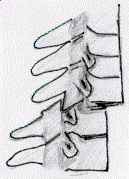- Discussion:
- integrity of all ligaments of cervical canal is lost, including posterior ligaments, anterior & posterior longitudinal ligaments, disc, and articular facet joints;
- this type of injury occurs only when middle & posterior ligamentous structures are disrupted;
- there are typically no frxs of facets because posterior column is distracted;
- bilateral facet dislocations (& facet frx) have higher incidence of redislocation following reduction;
- this injury is considered unstable;
- important injury is the soft tissue injury;
- there may be complete dislocation of the facets, w/ inferior articular facets of body above lying anterior w/ respect to superior articular facet
of body below (bilateral locked facets);
- when this occurs there is a 50% anterior subluxation at involved level;
- diff dx:
- unilateral dislocations
- facet joint injuries
- hyperflexion injuries
- pure distraction injury (will be made worse w/ traction);
- facet subluxation: bilateral subluxation will show only a few milimeters of anterolithesis;
- associated injuries:
- disc herniation
- may occur in 10% of pts who have facet subluxation or dislocation;
- in pts who have such injury, catastrophic compression of spinal cord can result from an uncontrolled facet reduction;
- epidural hematoma:
- may result in neurologic comprimise once reduction is achieved;
- look for blood collection posterior to cord;
- mechanism:
- is thought to represent a hyperflexion injury
- flexion-rotation injuries to C-spine can cause dislocation of the vertebral bodies;
- in this injury, facet joint dislocate,"jump" over one another, and become locked;
- consequently, injury is often described as jumped locked facets;
- dislocation may either be unilateral or bilateral;
- if dislocation is not complete, the facets may be said to be perched upon one another;
- Clinical Presentation:
- unfortunately neurologic injuries are common w/ this injury;
- unilat jump locked facets have better prognosis, as vertebral body can-not sublux forward > 25% of disk space, causing less cord impingment;
- bilateral jump locked facets usually cause at least 50% subluxation of the vertebral body;

- Radiographs:
- besides a lateral view, consider ordering oblique view, and pillar view;
- bilateral jumped facets likely when displacement is > 50% anterior subluxation on lateral view;
- look for:
- dislocation or frx of superior or inferior articular facets;
- widening of interspinous distance on AP film;
- narrowing of the disk space at the injured level may indicate possible extrusion of a disk fragment;
- in this case an MRI should precede attempts at reduction;
- on oblique films, articular mass lies in intervertebral foramen;
- dislocation may be incomplete, w/ varying degrees of anterolisthesis of facets of one body with respect to another;
- Reduction: (Considerations and Technique)
- Post Reduction Care:
- management of the spine injured patient:
- neurologic recovery may improve w/ realignment;
- usual treatment following reduction is spinous process wiring and arthrodesis w/ mobilization in upright posture as rapidly as tolerated postop;
- halovest management after closed reduction has also been used;
- potential problems include redislocation, inadequate healing, & scapular or other decubiti in pts w/ insensate skin;
- Operative Treatment:
- bilateral facet dislocations & facet dislocations w/ frx have higher incidence of redislocation following reduction;
- this injury involves disruption of virtually all ligaments& disk;
- therefore operative stabilization and fusion is indicated indicated;
- because reduction of the facets restores rotational stability, simple midline posterior cervical wiring can be used for internal stabilization;
- w/ wire fixation patient can be immobilized in a hard collar;
- important unresolved issue is how to predict which pt is at sufficient risk to warrant anterior diskectomy before realignment;
- disk herniation is often assoc w/ bilateral dislocations& may be exacerbated by reduction, leading to neurologic deficit;
- MRI or myelography is useful in this regard;
- anterior approach and reduction:
- anterior approach to the cervical spine;
- in bilateral facet dislocation, posterior ligamentous complex is disrupted, usually w/ preservation of anterior longitudinal ligament;
- anterior approach that fails to account for posterior source of instability might result in loss of position and resubluxation postoperatively;
- stability in these innstance can be achieved with posteror arthrodesis and interspinous wiring, and a foraminotomy for nerve root decompression
might be accomplished at the same time;
- The Edwin Smith Papyrus: Dislocation of a cervical vertebra -
TITLE : Instructions concerning a dislocation in a vertebra of his neck.
EXAMINATION : If thou examinest a man having a dislocation in a vertebra of his neck, shouldst thou find him unconscious
of his two arms (and) his two legs on account of it, while his phallus is erected on account of it, (and) urine drop
from his member without his knowing it; his flesh has receives wind ; his two eyes are blood-shot; it is a dislocation
of a vertebra of his neck extending to his back-bone which causes him to be unconscious of his two arms (and) his two
legs. If , however , the middle vertebra of his neck is dislocated , it is an emissio seminis which befalls his phallus.
DIAGNOSIS : Thou shouldst say concerning him : "One having a dislocation in a vertebra of his neck , while he is unconscious of
his two legs and his two arms, and his urine dribbles. An ailment not to be treated."
Closed reduction of cervical spine dislocations.
Unilateral facet dislocations and fracture-dislocations of the cervical spine.
Progressive paralysis after bilateral facet dislocation of the cervical spine.
Images in Clinical Medicine. Reversal of Traumatic Quadriplegia after Closed Reduction


